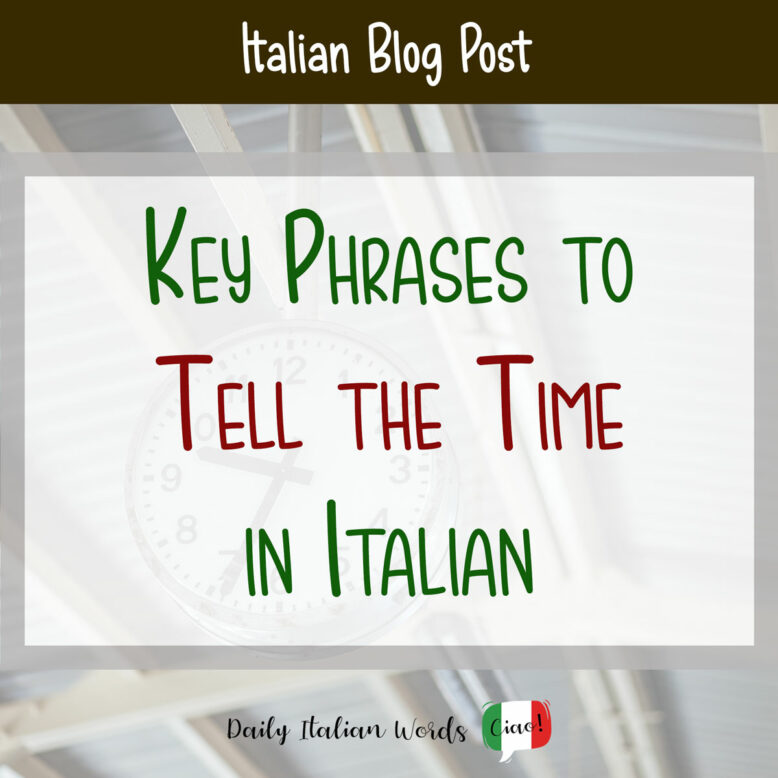Have you ever found yourself without a working phone, no watch on your wrist, and desperately needing to know the time? It’s in these moments that knowing how to ask for the time can be incredibly handy! Whether you’re preparing for a trip to Italy or simply fascinated by the language, mastering the art of telling time in Italian is a skill that’s always useful!

How to ask for the time in Italian
Before we dive into how to tell the time in Italian, let’s first learn how to ask the all-important question: What time is it? Your go-to phrases, simple and direct, are:
Che ora è?
(literally: What hour is it?)
Che ore sono?
(literally: What hours are they?)
They are equally valid, so you can pick whichever you prefer.
If you’re stopping someone on the street, you might want to be a tad more polite. Here’s how you do it:
Scusa, mi puoi dire l’ora per favore?
Excuse me, can you tell me the time please?
(if you’re approaching someone you know or who’s younger)
Scusi, mi può dire l’ora per favore?
Excuse me, can you tell me the time please?
(for a more formal tone, perfect when you’re addressing someone you don’t know well)
Need to know when something specific is happening, like when that awesome concert starts or what time the museum opens? In such cases, the phrase to use is A che ora… (At what time…):
Scusa, a che ora inizia la partita?
Excuse me, what time does the game start?
Mi scusi, a che ora aprono i negozi?
Excuse me, what time do the shops open?
And if you’re curious about how long something lasts or until what time a place is open, just remember Fino a che ora…? (Until what time…?):
Fino a che ora è aperto il museo?
Until what time is the museum open?
Fino a che ora è possibile fare il check in?
Until what time is it possible to check in?

Telling the time in Italian using the 12-hour clock
To tell the time in Italian, you typically start with sono (meaning “are“) followed by the feminine definite article le before stating the number. However, there’s an exception at one o’clock, where you use è (meaning “is“) along with the singular feminine definite article la (the).
Instead, to say at what hour something happens, you must use the preposition alle (at) or all’ for one o’clock.
The use of the feminine article before the number is due to the fact that ora (hour) in Italian is feminine.
- È l’una / All’una – it’s /at one o’clock
- Sono le due / Alle due – It’s / at two o’clock
- Sono le tre / Alle tre – It’s / at three o’clock
- Sono le quattro / Alle quattro – It’s / at four o’clock
- Sono le cinque / Alle cinque – It’s / at five o’clock
- Sono le sei / Alle sei – It’s / at six o’clock
- Sono le sette / Alle sette – It’s / at seven o’clock
- Sono le otto / Alle otto – It’s / at eight o’clock
- Sono le nove / Alle nove – It’s / at nine o’clock
- Sono le dieci / Alle dieci – It’s / at ten o’clock
- Sono le undici / Alle undici – It’s / at eleven o’clock
- Sono le dodici / Alle dodici – It’s / at twelve o’clock
For example:
A: Scusa, che ore sono? (Excuse me, what time is it?)
B: È l’una (It’s one o’clock)
A: Scusi, a che ora passa il prossimo autobus? (Excuse me, at what time does the next bus pass?)
B: All’una! (At one o’clock!)

How to indicate AM and PM in Italian
In Italian, when you’re using the 12-hour clock and want to avoid any mix-up between daytime and nighttime — because there’s no “AM” or “PM” in Italian — you need to add a little something extra after the time:
- di mattina (in the morning)
- di/del pomeriggio (in the afternoon)
- di sera (in the evening)
- di notte (at night)
So, instead of saying “8 AM” or “8 PM,” Italians would say 8 di mattina or 8 di sera to make it crystal clear whether it’s morning or evening. Here are some examples:
- È stato un viaggio lunghissimo, sono arrivata a casa all’una di notte. (It’s been a long journey, I arrived home at 1 in the morning.)
- Domani inizio il turno alle 8 di sera. (Tomorrow I start my shift at 8 in the evening.)

The 24-hour time format in Italian
While the 12-hour clock is common in Italy, the 24-hour clock is also used, especially in transportation schedules, business, and written communication more in general. Here’s how it works:
- 1AM: È l’una / All’una
- 2AM: Sono le due / Alle due
- 3AM: Sono le tre / Alle tre
- 4AM: Sono le quattro / Alle quattro
- 5AM: Sono le cinque / Alle cinque
- 6AM: Sono le sei / Alle sei
- 7AM: Sono le sette / Alle sette
- 8AM: Sono le otto / Alle otto
- 9AM: Sono le nove / Alle nove
- 10AM: Sono le dieci / Alle dieci
- 11AM: Sono le undici / Alle undici
- 12PM: Sono le dodici / Alle dodici
- 1PM: Sono le tredici / Alle tredici
- 2PM: Sono le quattordici / Alle quattordici
- 3PM: Sono le quindici / Alle quindici
- 4PM: Sono le sedici / Alle sedici
- 5PM: Sono le diciassette / Alle diciassette
- 6PM: Sono le diciotto / Alle diciotto
- 7PM: Sono le diciannove / Alle diciannove
- 8PM: Sono le venti / Alle venti
- 9PM: Sono le ventuno / Alle ventuno
- 10PM: Sono le ventidue / Alle ventidue
- 11PM: Sono le ventitré / Alle ventitré
- 12AM: Sono le ventiquattro / Alle ventiquattro, but it’s much more common to say è mezzanotte / a mezzanotte (it’s / at midnight)
So, for example, to say it’s 8 PM in Italian, you could either say sono le 8 (di sera) or sono le venti. Here are some examples:
- Il concerto inizia alle ventuno (The concert starts at 9pm)
- Devo tornare a casa prima di mezzanotte (I need to return home before midnight)
Telling the minutes in Italian
Now, since the time is not always on the hour, here’s how you can get more specific:
- Exact minutes: when you want to be precise, especially in formal settings like schedules, you add the exact minute after stating the hour. For instance, La lezione inizia alle dieci e cinque (The class starts at five past ten), Ci vediamo alle due e dieci! (See you at ten past two!)
- Half past: when it’s thirty minutes past the hour, you can say e mezza or e mezzo to indicate half past. Both are correct, and you can choose whichever sounds more musical to your ears. For example: Mi sveglio sempre alle sei e mezza (I always wake up at half past six).
- Minutes to the hour: starting from 40 minutes past, Italians say the minutes to the next hour. For instance, 9:55 becomes:
- Sono le dieci meno cinque (lit. It’s ten minus five)
- Mancano cinque minuti alle dieci (lit. There are five minutes missing to ten)
- Sono le nove e cinquantacinque (lit. It’s nine fifty-five – a bit more formal, suitable for announcements or schedules).
- Quarter past: if it’s fifteen minutes past the hour, you say e un quarto. For example: Sono le quattro e un quarto, tempo per un caffè (It’s a quarter past four, time for coffee!)
- Quarter to: when it’s fifteen minutes until the next hour, you use the next hour and say sono le…meno un quarto or manca un quarto alle… For example, 18:45 becomes Sono le sette meno un quarto or Manca un quarto alle sette. Sometimes, you might also hear Sono le sei e tre quarti (lit, it’s six and three quarters).
- No exact minute: In casual speech, Italians often use passate (past) or quasi (almost) instead of specifying exact minutes. For example, 15:12 becomes Sono le tre e dieci passate (It’s past three ten) or Sono quasi le tre e un quarto (it’s almost a quarter past three).
Useful time expressions and time-related vocabulary in Italian
Italians have two main ways to express the equivalent of o’clock in English:
- in punto (sharp) to emphasise that the time is exactly as stated. For example: Domani si parte alle nove in punto, chi ritarda resta a casa! (Tomorrow we leave at nine sharp; anyone who’s late stays home!)
- spaccate (sharp) is perfect for casual conversations. For instance: Devo tornare a casa alle 10 spaccate, altrimenti mia madre si arrabbia. (I have to be back home at exactly 10; otherwise, my mother gets angry)
Sometimes you may need to add some extra elements to give more temporal context when telling the time and the activities you are describing:
To talk about present events:
- Adesso (now)
- Ora (now)
- In questo momento (at this moment)
- Oggi (today)
- Oggi pomeriggio (this afternoon)
- Questa mattina / stamattina (this morning)
- Questa sera / stasera (this evening)
- Questa notte / stanotte (tonight)
To talk about past events:
- Ieri (yesterday)
- Ieri mattina/pomeriggio/sera/notte (yesterday morning/afternoon/evening/night)
- L’altro ieri (the day before yesterday)
- L’altro giorno (the other day)
- Poco fa (a short time ago)
- Due giorni fa (two days ago)
- Una settimana fa (one week ago)
- Due anni fa (two years ago)
- La settimana scorsa (last week)
- Il mese scorso (last month)
- L’anno scorso (last year)
To talk about future events:
- Domani (tomorrow)
- Domani mattina/pomeriggio/sera/notte (tomorrow morning/afternoon/evening/night)
- Dopodomani (the day after tomorrow)
- Tra/Fra due giorni (in two days)
- Tra/Fra un mese (in a month)
- Tra/Fra due anni (in two years)
- La settimana prossima (next week)
- Il mese prossimo (next month)
- L’anno prossimo (next year)
There are a few more essential terms to round out your knowledge:
- Mezzogiorno (noon)
- Mezzodì (noon)
- Mezzanotte (midnight)
- La mezza (12:30pm or 12:30am)
- Ora (time)
- Orologio (clock)
- Tardi (late)
- Presto (early)
- Essere in orario (to be on time)
- Essere puntuali (to be on time)
- Essere in ritardo (to be late)
- Essere in anticipo (to be early)

Valentina Nicastro is a travel writer in love with her home country, Italy. Having travelled widely around the globe, she realised there was more to explore closer to home and decided to put the passport aside for a while. When she is not immersed in documenting Italy, you’ll find her donning her communication consultant hat, weaving words as a content writer and bridging linguistic divides as a translator.


